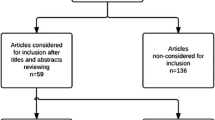Abstract
Background
Some technical aspects of laparoscopic spleen surgery still are debated, although efforts have been made to standardize them. The position of the patient, the approach to the spleen, vessel identification and division, and spleen extraction can vary from center to center.
Methods
This retrospective muticentric study led by the Società Italiana di Videochirurgia Infantile (SIVI) examined indications, surgical details, and complications of laparoscopic spleen surgery in the pediatric population during a 5-year period.
Results
The study period from January 1999 to December 2003 (5 years) involved nine centers and included 85 patients with a mean age of 10 years (range, 2–17 years). Hypersplenism or severe hemolysis in cases of hematologic disorders represented the most important indications. More than 90% of the patients underwent total laparoscopic splenectomy. Specific technical details from each center were collected. Intraoperative complications occurred in 19% of the patients (hemorrhage in 8% and technical problems in 14%), and 6% of the patients required conversion to the open approach. No deaths occurred, and no reoperations were required. Postoperative complications were experienced by 2% of the patients.
Conclusion
Laparoscopic spleen surgery is safe, reliable, and effective in the pediatric population. On the basis of the results, some technical details for laparoscopic spleen surgery can be suggested. The patient is preferably kept supine or lateral, approaching the spleen anteriorly. Moreover, the ilar vessels should be identified selectively and individually, with initial artery division performed to achieve spleen shrinking. Any hemostatic device proved to be effective in experienced hands. Once freed, the spleen is preferably extracted via a suprapubic cosmetic transverse incision (faster, easier, and safer), although a bag can be used. Finally, the size of the spleen does not represent a contraindication for a trained and experienced surgeon. Nevertheless, this parameter must be considered when laparoscopic spleen surgery is planned.
Similar content being viewed by others
References
Bax NMA, Van Der Zee D (2001) Laparoscopic splenectomy: is this the way to do it? Pediatr Endosurg Innov Tech 5: 281–286
Castagnola E, Fioredda F (2003) Prevention of life-threatening infections due to encapsulated bacteria in children with hyposplenia or asplenia: a brief review of current recommendations for practical purposes. Eur J Haematol 71: 319–326
Cusick RA, Waldhausen JHT (2001) The learning curve associated with pediatric laparoscopic splenectomy. Am J Surg 181: 393–397
de Lagausie P, Bonnard A, Benkerrou M, Rorlich P, de Ribier A, Aigrain Y (2004) Pediatric laparoscopic splenectomy: benefits of the anterior approach. Surg Endosc 18: 80–82
Durgun V, Kapan S, Kapan M, Karabicak I, Aydogan F, Goksoy E (2003) Primary splenic hydatidosis. Dig Surg 20: 38–41
Eber SW, Ambrust R, Schroter W (1990) Variable clinical severity of hereditary spherocytosis: relation to erythrocytic spectrin concentration, osmotic fragility, and autohemolysis. J Pediatr 177: 409–411
Esposito C, Shaarschmidt K, Settimi A, Montupet P (2002) Experience with laparoscopic splenectomy. J Pediatr Surg 36: 309–311
Heniford BT, Park A, Walsh RM, Kercher KW, Matthews BD, Frenette G, Sing RF (2001) Laparoscopic splenectomy in patients with normal-sized spleens versus splenomegaly: does size matter? Am Surg 67: 854–857
Liu DC, Meyers MO, Hill CB, Loe WA Jr (2000) Laparoscopic splenectomy in children with hematological disorders: preliminary experience at the Children’s Hospital of New Orleans. Am Surg 66: 1168–1170
Minkes RK, Lagzdins M, Langer JC (2000) Laparoscopic versus open splenectomy in children. J Pediatr Surg 35: 699–701
Mittelman M, Kyzer S, Zeidman A, Bendayan D, Ramadan E, Cohen A, Cahimoff C (1997) Splenectomy for haematological diseases: a single institution experience. Haematologia 28: 185–198
Pomp A, Gagner M, Salky B, Caraccio A, Nahouraii R, Reiner M, Herron D (2005) Laparoscopic splenectomy: a selected retrospective review. Surg Laparosc Endosc Percutan Tech 15: 139–143
Reddy VS, Phan HH, O’Neill JA, Neblett WW, Pietsch JB, Morgan WM, Cywes R, Holcomb GW III (2001) Laparoscopic versus open splenectomy in the pediatric population: a contemporary single centre experience. Am Surg 67: 859–863
Rescorla FJ, Engum SA, West KW, Tres Scherer LR III, Rouse TM, Grosfeld JL (2002) Laparoscopic splenectomy has become the gold standard in children. Am Surg 68: 297–301
Romano F, Caprotti R, Franciosi C, De Fina S, Colombo G, Sartori P, Uggeri F (2003) The use of LigaSure during pediatric laparoscopic splenectomy: a preliminary report. Pediatr Surg Int 19: 721–724
Rosen M, Brody F, Walsh RM, Tarnoff M, Malm J, Ponsky J (2002) Outcome of laparoscopic splenectomy basing on hematologic indication. Surg Endosc 16: 272–279
Rothemberg SS (1998) Laparoscopic splenectomy in children. Semin Laparosc Surg 5: 19–24
Sandler A, Winkel G, Kimura K, Soper R (1999) The role of prophylactic cholecystectomy during splenectomy in children with hereditary spherocytosis. J Pediatr Surg 34: 1077–1078
Sandoval C, Stringel G, Ozkaynak MF, Tugal O, Jayabose S (2000) Laparoscopic splenectomy in pediatric patients with hematologic diseases. JSLS 4: 117–120
Sharma AK, Rangam HK, Choubey RP (2000) Splenectomy and lienorenal shuntfor extrahepatic portal venous obstruction. Indian Pediatr 37: 422–425
Shaw JHS, Print CG (1989) Postsplenectomy sepsis. Br J Surg 76: 1074–1081
Tulman S, Holcomb GW, Karamanoukian HL, Reynhout J (1993) Pediatric laparoscopic splenectomy. J Pediatr Surg 28: 689–692
Van Der Zee DC, Kramer WL, Ure BM, Mkhaberi B, Bax NM (1999) Laparoscopic management of a large posttraumatic cyst in a child. Surg Endosc 13: 1241–1242
Vasilescu C, Stanciulea O, Colita A, Stoia R, Moicean A, Arion C (2003) Laparoscopic subtotal splenectomy in the treatment of hereditary spherocytosis. Chirurgia (Bucur) 98: 571–576
Vasilescu C, Tomulescu V, Ciurea S, Popescu I (2001) Laparoscopic splenectomy: lessons learned from a series of 40 cases: the advantages of the posterolateral approach. Chirurgia (Bucur) 96: 231–236
Author information
Authors and Affiliations
Corresponding author
Rights and permissions
About this article
Cite this article
Mattioli, G., Pini Prato, A., Cheli, M. et al. Italian multicentric survey on laparoscopic spleen surgery in the pediatric population. Surg Endosc 21, 527–531 (2007). https://doi.org/10.1007/s00464-006-9035-5
Received:
Revised:
Accepted:
Published:
Issue Date:
DOI: https://doi.org/10.1007/s00464-006-9035-5




